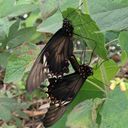Birdwings, Cattlehearts and Aristolochia Swallowtails
Troidini
Classification
- Phylum: Arthropoda
- Subphylum: Hexapoda
- Class: Insecta
- Order: Lepidoptera
- Superfamily: Papilionoidea
- Family: Papilionidae
- Subfamily: Papilioninae
- Tribe: Troidini
Pronunciation
How to pronounce Troidini: /troɪˈdiːnaɪ/
These audio files are automatically generated. While they are not always 100% accurate, they are a good starting point.
Images






Summary
Troidini is a diverse tribe of large, strikingly colored swallowtail butterflies known for their distinctive mimicry and larval diet on pipevine plants which renders them poisonous and unpalatable to predators.
Physical Characteristics
Members of Troidini are superlatively large among butterflies, exhibiting striking colors and significant wingspan and surface area.
Identification Tips
Look for large, brightly colored butterflies that often mimic other butterflies due to their unpalatability.
Habitat
Troidini butterflies are typically found in areas where their larval food plants, pipevine plants, are present.
Distribution
Troidini has a global distribution; specific locations depend on the genus and species.
Diet
Larvae of Troidini feed primarily on poisonous pipevine plants, particularly from the genus Aristolochia.
Life Cycle
The life cycle includes egg, larval, pupal, and adult stages, with a focus on mimicking the appearance of unpalatable species during the adult stage.
Predators
Birds and other predators that are capable of consuming butterflies may prey on them, although Troidini members are generally unpalatable due to their diet.
Ecosystem Role
Troidini butterflies play a role in pollination and serve as prey for various predators, forming part of the ecological web.
Misconceptions
Some may think Troidini butterflies are solely harmless, while they possess chemicals that deter predators, making them unpalatable.
Tags
- Troidini
- Swallowtail Butterflies
- Birdwings
- Cattlehearts
- Aristolochia Swallowtails